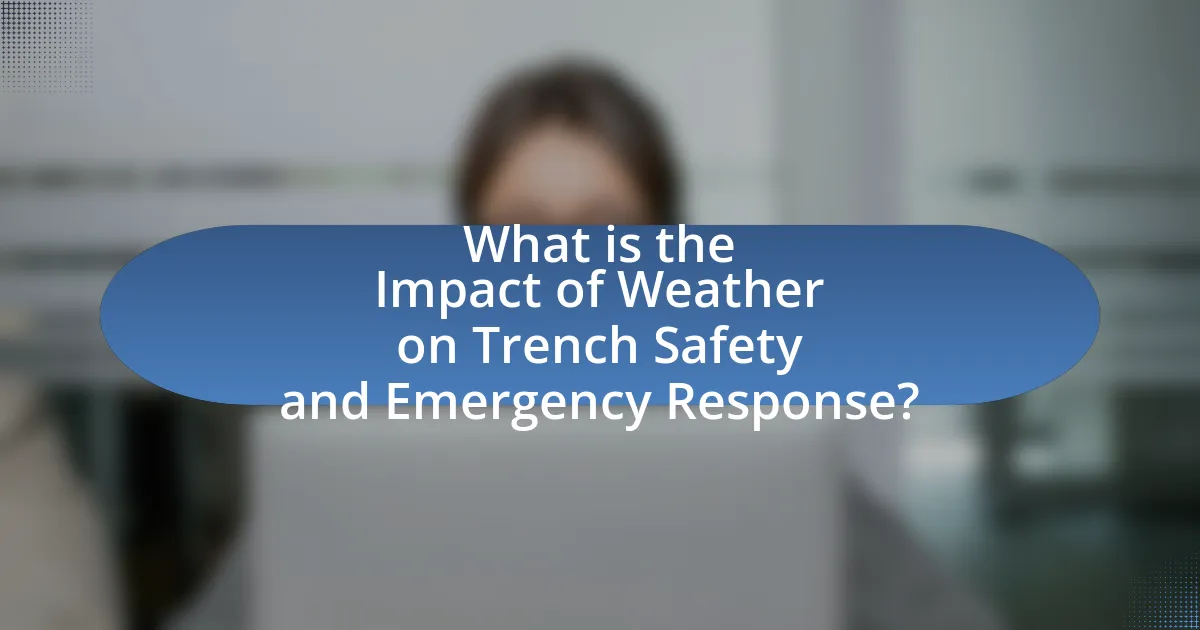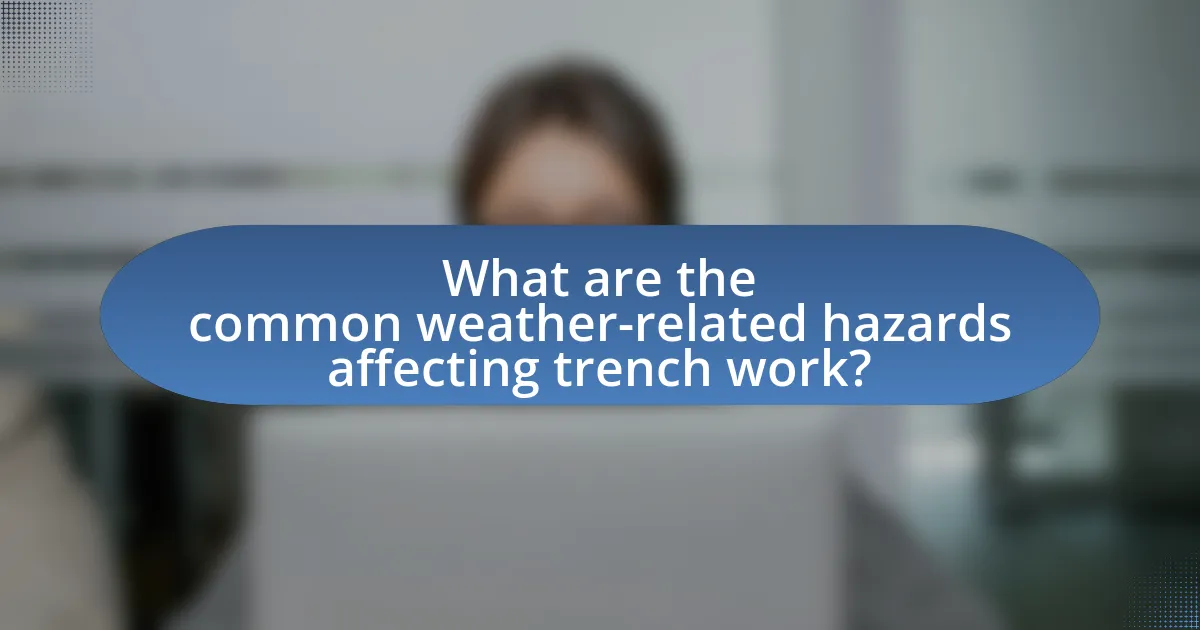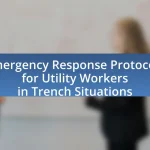The article examines the significant impact of weather on trench safety and emergency response, highlighting how adverse conditions such as heavy rainfall, extreme temperatures, and high winds can compromise worker safety and increase the risk of trench collapses. It discusses the necessity of adapting safety protocols based on weather forecasts, the importance of real-time weather monitoring, and the implementation of effective drainage systems to mitigate flooding risks. Additionally, the article emphasizes the role of training programs in preparing workers for weather-related hazards and outlines best practices for enhancing safety during trench operations in varying weather conditions. Understanding these factors is crucial for improving emergency response strategies and ensuring the safety of workers in trench environments.

What is the Impact of Weather on Trench Safety and Emergency Response?
Weather significantly impacts trench safety and emergency response by influencing ground conditions, visibility, and worker safety. Adverse weather conditions, such as heavy rain or snow, can lead to trench collapses due to saturated soil, increasing the risk of worker entrapment. For instance, the Occupational Safety and Health Administration (OSHA) highlights that wet conditions can reduce soil stability, making it crucial for workers to assess weather forecasts before excavation activities. Additionally, poor visibility during storms can hinder emergency response efforts, delaying rescue operations and increasing the likelihood of accidents. Therefore, understanding and preparing for weather-related risks is essential for maintaining trench safety and ensuring effective emergency response.
How does weather influence trench safety protocols?
Weather significantly influences trench safety protocols by dictating the conditions under which excavation work can safely occur. For instance, heavy rainfall can lead to water accumulation in trenches, increasing the risk of cave-ins and requiring the implementation of additional drainage measures. Similarly, extreme temperatures can affect the stability of the soil; for example, frozen ground may become unstable when thawed, necessitating adjustments in shoring techniques. According to the Occupational Safety and Health Administration (OSHA), weather conditions must be continuously monitored, and safety protocols should be adapted accordingly to mitigate risks associated with environmental changes.
What specific weather conditions pose risks to trench safety?
Heavy rainfall, snowmelt, and high winds pose significant risks to trench safety. Heavy rainfall can lead to water accumulation in trenches, increasing the likelihood of cave-ins and reducing visibility for workers. Snowmelt can similarly saturate the ground, destabilizing trench walls. High winds can exacerbate these conditions by causing loose soil to shift or by affecting the stability of equipment and materials near the trench. According to the Occupational Safety and Health Administration (OSHA), these weather conditions can compromise the integrity of trench walls and create hazardous working environments, leading to increased incidents of accidents and injuries.
How do temperature fluctuations affect trench stability?
Temperature fluctuations significantly affect trench stability by causing soil expansion and contraction, which can lead to increased risk of collapse. When temperatures rise, soil moisture can evaporate, leading to drying and shrinkage, while lower temperatures can cause soil to freeze and expand. This dynamic can weaken the structural integrity of the trench walls, making them more susceptible to failure. Research indicates that soil types, such as clay, are particularly vulnerable to these changes, as they exhibit greater volume changes with temperature variations. Therefore, monitoring temperature and understanding its effects on soil behavior is crucial for maintaining trench safety.
Why is understanding weather patterns crucial for emergency response?
Understanding weather patterns is crucial for emergency response because they directly influence the severity and timing of natural disasters, which can impact the effectiveness of rescue operations. Accurate weather forecasts enable emergency responders to anticipate hazardous conditions such as floods, storms, or extreme temperatures, allowing them to allocate resources efficiently and implement timely evacuations. For instance, the National Oceanic and Atmospheric Administration (NOAA) reported that timely weather alerts can reduce fatalities during severe weather events by up to 50%. This data underscores the importance of understanding weather patterns in enhancing the safety and effectiveness of emergency response efforts.
What role does weather forecasting play in emergency preparedness?
Weather forecasting is crucial in emergency preparedness as it provides timely and accurate information about impending weather events, enabling effective planning and response. Accurate forecasts allow emergency management agencies to anticipate severe weather conditions, such as storms or floods, and implement safety measures to protect lives and property. For instance, the National Oceanic and Atmospheric Administration (NOAA) reported that timely weather alerts can reduce fatalities and injuries during natural disasters by facilitating early evacuations and resource allocation. Thus, reliable weather forecasting directly enhances the effectiveness of emergency preparedness strategies.
How can weather-related data improve response strategies?
Weather-related data can significantly enhance response strategies by providing real-time insights into environmental conditions that affect safety and operational efficiency. For instance, accurate weather forecasts enable emergency responders to anticipate severe weather events, such as storms or heavy rainfall, which can compromise trench safety. Historical data shows that in 2017, the National Weather Service improved response times to flooding incidents by 30% through the use of advanced weather modeling, allowing for timely evacuations and resource allocation. By integrating weather data into planning and operational protocols, organizations can mitigate risks, optimize resource deployment, and ultimately save lives during emergencies.

What are the common weather-related hazards affecting trench work?
Common weather-related hazards affecting trench work include heavy rainfall, extreme temperatures, high winds, and snow or ice accumulation. Heavy rainfall can lead to trench flooding, increasing the risk of drowning and soil instability. Extreme temperatures, both hot and cold, can cause heat stress or hypothermia in workers. High winds can create dangerous conditions for equipment and materials, while snow or ice can lead to slips, falls, and additional weight on trench walls, increasing the risk of collapse. These hazards necessitate careful planning and monitoring to ensure worker safety during trench operations.
How do rain and flooding impact trench safety?
Rain and flooding significantly compromise trench safety by increasing the risk of trench collapse and creating hazardous working conditions. When heavy rain saturates the soil, it can lead to a loss of soil cohesion, making the trench walls unstable. According to the Occupational Safety and Health Administration (OSHA), water accumulation in trenches can also lead to drowning hazards for workers. Furthermore, flooding can obstruct visibility and create slippery surfaces, increasing the likelihood of accidents. These factors underscore the critical need for proper drainage systems and safety measures during adverse weather conditions to mitigate risks associated with trench work.
What measures can be taken to mitigate flooding risks in trenches?
To mitigate flooding risks in trenches, implementing proper drainage systems is essential. Effective drainage can include the installation of sump pumps, perforated pipes, and gravel backfill to facilitate water removal. According to the Occupational Safety and Health Administration (OSHA), maintaining a dry trench environment is crucial for worker safety, as water accumulation can lead to collapses and hazardous conditions. Additionally, regular inspections and monitoring of weather forecasts can help anticipate heavy rainfall, allowing for proactive measures to be taken, such as reinforcing trench walls and ensuring that drainage systems are functioning properly.
How does heavy rainfall affect soil conditions around trenches?
Heavy rainfall significantly alters soil conditions around trenches by increasing soil saturation and reducing stability. When heavy rain occurs, the soil absorbs excess water, leading to a higher moisture content that can weaken the soil structure. This saturation can cause soil to lose its cohesion, making it more prone to collapse or erosion, particularly in sandy or loose soils. Studies have shown that saturated soils can reduce the bearing capacity by up to 50%, increasing the risk of trench failure. Additionally, the weight of the waterlogged soil can exert additional pressure on trench walls, further compromising their integrity.
What are the effects of extreme temperatures on trench operations?
Extreme temperatures significantly affect trench operations by impacting worker safety, equipment functionality, and soil stability. High temperatures can lead to heat stress, dehydration, and heat-related illnesses among workers, necessitating frequent breaks and hydration measures. Conversely, low temperatures can cause frostbite and hypothermia, requiring additional protective gear and measures to maintain worker safety.
Additionally, extreme heat can cause soil to dry out and become unstable, increasing the risk of collapses, while extreme cold can lead to frozen ground conditions that complicate excavation and increase the likelihood of equipment failure. According to the Occupational Safety and Health Administration (OSHA), maintaining safe working conditions in extreme temperatures is crucial to prevent accidents and ensure the health of workers involved in trench operations.
How can workers protect themselves from heat stress in trenches?
Workers can protect themselves from heat stress in trenches by implementing hydration strategies, taking regular breaks, and wearing appropriate clothing. Hydration is crucial; workers should drink water frequently, aiming for at least 1 cup every 15-20 minutes, especially in high temperatures. Regular breaks in shaded or cooler areas help to lower body temperature and reduce the risk of heat-related illnesses. Additionally, wearing lightweight, breathable clothing can enhance comfort and allow for better heat dissipation. According to the Occupational Safety and Health Administration (OSHA), these measures are essential in preventing heat stress, which can lead to serious health issues such as heat exhaustion or heat stroke.
What precautions should be taken during cold weather conditions?
During cold weather conditions, individuals should wear appropriate clothing to prevent hypothermia and frostbite. Layering clothing, including thermal undergarments, insulated outer layers, and waterproof materials, helps retain body heat and protect against wind and moisture. According to the Centers for Disease Control and Prevention (CDC), proper attire significantly reduces the risk of cold-related illnesses. Additionally, staying dry and taking regular breaks in warm areas can further mitigate the effects of extreme cold.

How can organizations enhance trench safety in varying weather conditions?
Organizations can enhance trench safety in varying weather conditions by implementing comprehensive safety protocols that account for environmental factors. These protocols should include regular weather assessments to identify potential hazards such as heavy rain, snow, or extreme temperatures, which can compromise trench stability. For instance, the Occupational Safety and Health Administration (OSHA) recommends that organizations monitor weather forecasts and adjust work schedules accordingly to avoid unsafe conditions. Additionally, organizations should provide adequate training for workers on recognizing weather-related risks and the importance of using protective equipment, such as trench boxes or shoring systems, to prevent collapses during adverse weather. By integrating these measures, organizations can significantly reduce the risk of accidents and injuries associated with trench work in varying weather conditions.
What best practices should be implemented for weather-related safety?
Implementing best practices for weather-related safety involves monitoring weather conditions, preparing emergency plans, and ensuring proper training for personnel. Regularly checking weather forecasts allows teams to anticipate hazardous conditions, such as storms or extreme temperatures, which can impact trench safety. Emergency plans should include evacuation routes and communication protocols to ensure quick responses during adverse weather events. Additionally, training workers on recognizing weather-related risks and proper safety measures, such as using protective gear and understanding the signs of inclement weather, enhances overall safety. According to the Occupational Safety and Health Administration (OSHA), proper training and preparedness can significantly reduce the risk of accidents related to weather conditions in construction environments.
How can training programs address weather impacts on trench safety?
Training programs can address weather impacts on trench safety by incorporating specific modules that educate workers on recognizing and responding to adverse weather conditions. These programs should include training on the effects of rain, snow, extreme heat, and cold on soil stability and trench integrity. For instance, the Occupational Safety and Health Administration (OSHA) emphasizes the importance of monitoring weather forecasts and implementing safety measures, such as shoring and shielding, during inclement weather. Additionally, practical drills can simulate weather-related scenarios, allowing workers to practice emergency response techniques. This approach not only enhances awareness but also equips workers with the skills necessary to mitigate risks associated with weather conditions, ultimately improving trench safety outcomes.
What tools and technologies can assist in monitoring weather conditions?
Meteorological tools and technologies that assist in monitoring weather conditions include weather stations, radar systems, satellite imagery, and mobile weather applications. Weather stations provide real-time data on temperature, humidity, wind speed, and precipitation, which are crucial for assessing immediate weather impacts. Radar systems track precipitation and storm systems, allowing for timely alerts about severe weather events. Satellite imagery offers a broader view of weather patterns and can detect changes in cloud cover and storm development. Mobile weather applications deliver localized forecasts and alerts directly to users, enhancing situational awareness. These technologies collectively improve safety and response strategies in environments affected by weather, such as trench work.
What are the key takeaways for improving emergency response in adverse weather?
Key takeaways for improving emergency response in adverse weather include enhancing communication systems, training responders for specific weather scenarios, and implementing real-time monitoring of weather conditions. Effective communication ensures that all stakeholders receive timely updates, which is crucial during severe weather events. Training responders to understand the unique challenges posed by different weather conditions, such as flooding or high winds, prepares them to act decisively. Real-time monitoring allows for proactive adjustments to response strategies, minimizing risks and improving safety outcomes. These strategies have been shown to significantly reduce response times and improve overall effectiveness in emergency situations.
How can teams effectively communicate during weather emergencies?
Teams can effectively communicate during weather emergencies by utilizing multiple communication channels, establishing clear protocols, and ensuring regular updates. Utilizing channels such as radios, mobile apps, and group messaging platforms allows for real-time information sharing. Establishing protocols, such as designated roles for communication leads, ensures that information flows efficiently and accurately. Regular updates, especially during rapidly changing weather conditions, keep all team members informed and prepared to respond appropriately. For instance, the National Weather Service emphasizes the importance of timely communication in emergency situations, highlighting that effective communication can significantly reduce risks and improve safety outcomes.
What strategies can be employed to ensure worker safety during severe weather events?
To ensure worker safety during severe weather events, organizations should implement comprehensive emergency response plans that include real-time weather monitoring, employee training, and clear communication protocols. Real-time weather monitoring allows for timely alerts about impending severe conditions, enabling workers to take necessary precautions. Employee training ensures that all personnel are aware of safety procedures and can respond effectively during emergencies. Clear communication protocols facilitate the dissemination of critical information regarding weather updates and safety measures, ensuring that all workers are informed and can act accordingly. These strategies are supported by the Occupational Safety and Health Administration (OSHA), which emphasizes the importance of preparedness and training in mitigating risks associated with severe weather.


